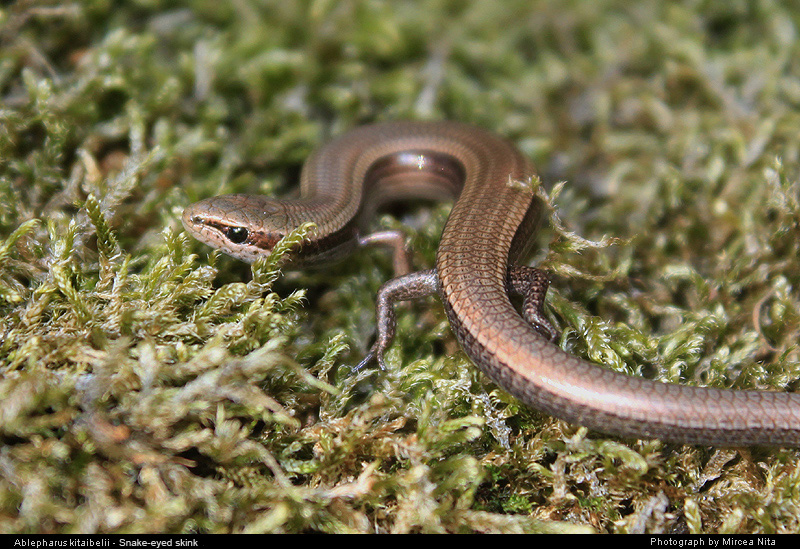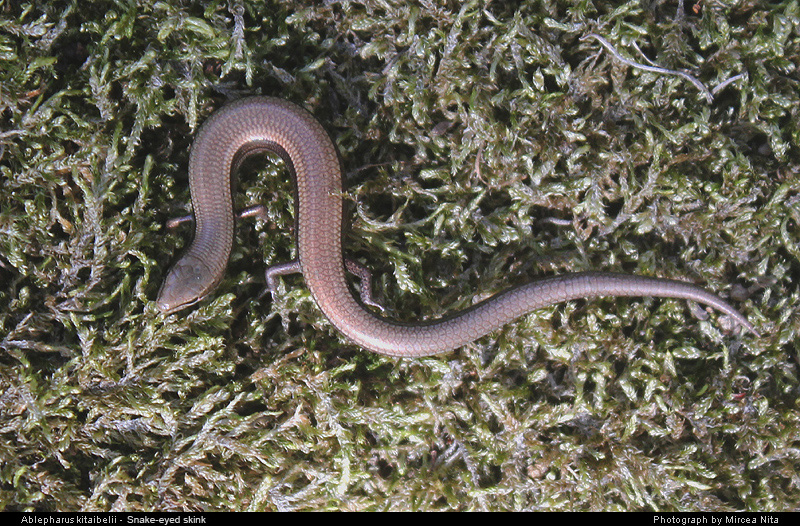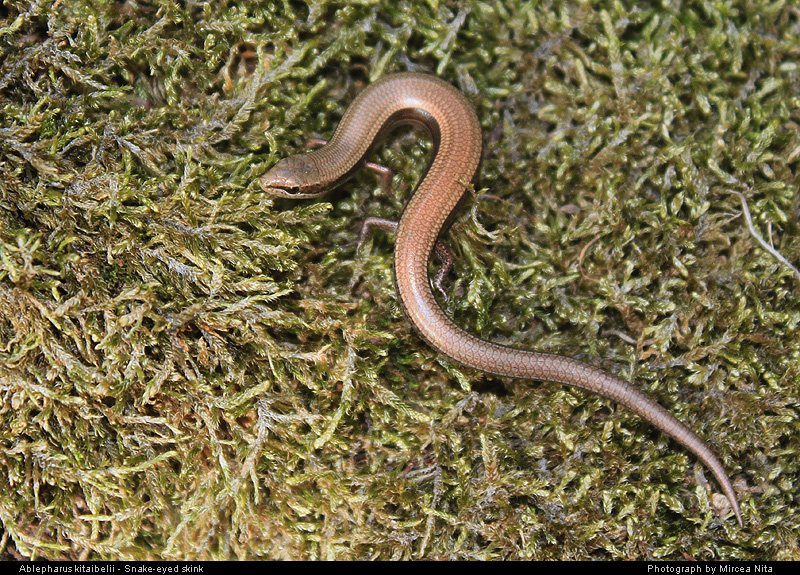| |





Ablepharus kitaibelii
Ablepharus kitaibelii - Bibron & Bory de Saint-Vincent, 1833
Common names: snake-eyed skink, european copper skink, juniper skink
Description:
The snake-eyed skink is a small slender lizard which grows up to 15 cm long, with a relatively thick tail, females being larger than males. It has a small head, short, round snout; without collar scales; small legs; without femoral pores; three supralabials anterior to eye and 18 scales around mid-body; dorsally and ventrally with big, striped scales.
Their skin is golden brown (bronze) colored with a metallic hue and characteristically dark dorso-lateral stripe that extends from the snout, through the eye, above the limbs onto the side of the tail, edged toward the mid-back with a light golden stripe. Mid dorsal is freckled with fine dark specks. Ventrally is grayish. The eyelids are immovable, in contrast to many other skinks, giving them their common name.
Their limbs are quite weak and when they grow larger they take-on a serpentine locomotion.
Biology:
Ablepharus kitaibelii basks during the day and can be found active at dusk. The female lays a clutch of two to four eggs. Development of the eggs takes around nine weeks, hatchlings are about 3 to 3.5 cm from snout to vent and reach maturity in about two years.
The snake-eyed skink is a shy species and is active during twilight, hunting for insects, small slugs and snails. It is a typical ground dweller, and dislikes climbing. Although they are not very nimble, due to their dense habitats they are found in, they manage to escape efficiently.
Habitat:
This species is found in dry areas including south facing slopes, meadows, scrubland and clearings in woodland (both deciduous and pine). It is generally found close to ground cover such as leaf-litter, dead wood, stones, bushes and other vegetation. It is a ground dwelling species mainly found in lowland areas but has also been found up to 2000m (in Turkey). At the south of its range it is found in quite damp habitats and tends to be active after rain in the spring and autumn.
Range:
This species lives in Eastern Europe and southwestern Asia being native to Greece (including the Aegean Islands), Cyprus, Romania, Bulgaria, the former Yugoslavia (through most of Serbia), the most eastern parts of continental Croatia (and newly discovered on Papuk Mountain in the central part of Croatia), Hungary, Albania, the Czech Republic, Slovakia, the Caucasus, Turkey (western and central)., Syria, Israel, Jordan, Lebanon, the Sinai Peninsula of Egypt and possibly Iraq. There is a single record from eastern Bosnia Herzegovina. Populations of the species in Hungary and southern Slovakia are very fragmented.
IUCN status:IUCN Red List = Least Concern
Listed as Strictly Protected under Appendix II of BERN Convention.
In parts of its European range the species is threatened by deforestation and conversion of suitable habitat to agricultural, forestry or industrial use.
Taxonomic notes:
Schmidtler (1997) raised the subspecies budaki, chernovi, and rueppellii to full species status, thus restricting Ablepharus kitaibelii to southeastern Europe and west and central Turkey. However, the taxonomy of this species is currently under review (P. Lymberakis pers. comm.). Ljubisvljevic et al. (2002) examined geographic variation in parts of the Balkan peninsula. Poulakakis et al. (2005) showed that A. kitaibelii is not monophyletic, and that the population on the Kastelorizo island group (Greece, off the Lycian coast of southwestern Turkey) is particularly distinct and deserves specific status. The remaining populations of A. kitaibelii consist of two clades, one comprising the populations inhabiting continental Greece and the west Aegean (Cyclades and Kithira) and Ionian (Leukada) islands, and the other comprising populations that inhabit the East Aegean islands (including "Crete") and Turkey.
Subspecies: Ablepharus kitaibelii fitzingeri, Ablepharus kitaibelii stepaneki, Ablepharus kitaibelii fabichi.
References:
Arnold, E. N., and Burton, J. A., 1978: A Field Guide to the Reptiles and Amphibians of Britain and Europe. Collins, London;
Böhme, W., Lymberakis, P., Ajtic, R., Tok, V., Ugurtas, I., Sevinç, M., Crochet, P.-A., Haxhiu, I., Sterijovski, B. & Krecsák, L. (2006). Ablepharus kitaibelii. In: IUCN 2006. IUCN Red List of Threatened Species;
Fuhn, I. & S. Vancea, 1961: Fauna Republicii Române, 14. Reptilia (Testoase, Sopârle, Serpi). Bucuresti;
Gasc, J.-P., A. Cabela, J. Crnobrnja-Isailovic, D. Dolmen, K. Grossenbacher, P. Haffner, J. Lescure, H. Martens, J.P. Martinez-Rica, H. Maurin, M.E. Oliveira, T.S. Sofianidou, M. Veith & A. Zuiderwijk, 1997: Atlas of Amphibians and Reptiles in Europe. - Societas Europaea Herpetologica und Muséum National d'Historie Naturelle (IEGB/SPN), Paris;
Joger, U. & N. Stümpel, 2005: Handbuch der Reptilien und Amphibien Europas, Wiebelsheim.
Europe, C.o., 2002. Convention on the conservation of European wildlife and natural habitats: Bern Convention
N. POULAKAKIS, P. LYMBERAKIS, C.S. TSIGENOPOULOS, A. MAGOULAS, M. MYLONAS: Phylogenetic relationships and evolutionary history of snake-eyed skink Ablepharus kitaibelii (Sauria: Scincidae), Molecular Phylogenetics and Evolution 34 (2005)
Gocmen, B., Y. Kumlutas and M. Tosunoglu,1996. A new subspecies, Ablepharus kitaibelii (Bibron and Borruy, 1833) budaki n. ssp. (Sauria: Scincidae) from Turkish Republic of Northern Cyprus. Tr. J. Zool., 20: 397-405;
Schmidtler, J.F., 1997. Die Ablepharus kitaibelii Gruppe in Süd -Anatolien und benachbarten Gebieten. Herpetozoa, 10:35-63;
|
|

